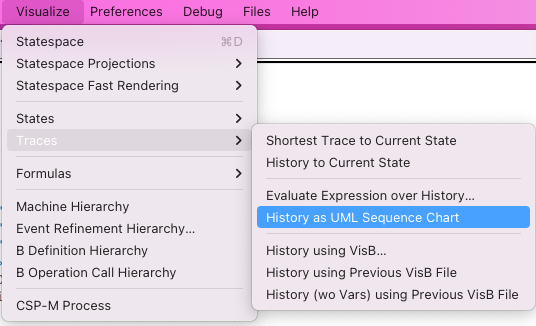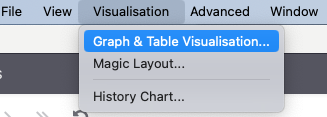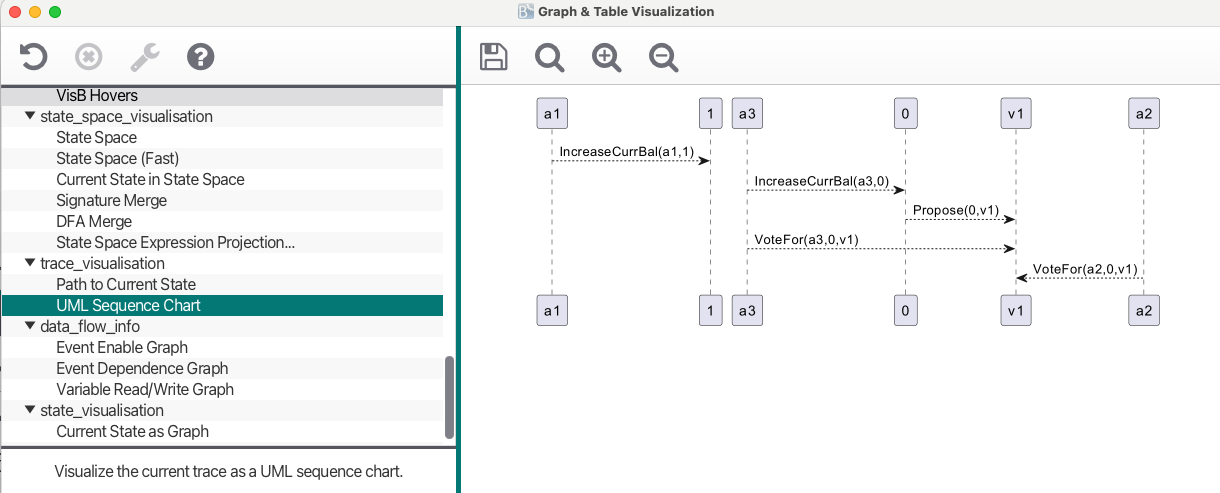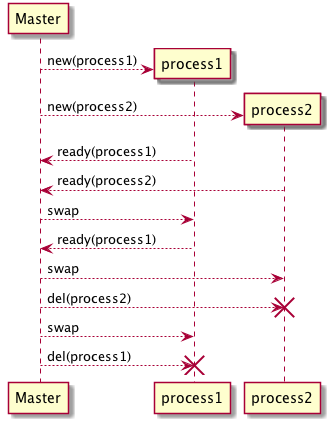Generating UML Sequence Charts: Difference between revisions
| (8 intermediate revisions by 2 users not shown) | |||
| Line 2: | Line 2: | ||
ProB has a new experimental feature to generate a UML sequence chart from the current animation trace using [https://plantuml.com PlantUML]. | ProB has a new experimental feature to generate a UML sequence chart from the current animation trace using [https://plantuml.com PlantUML]. | ||
It currently | The feature is available in ProB CLI, ProB Tcl/Tk and ProB2-UI. | ||
It currently works for classical B and TLA+ models and you need to copy the [https://plantuml.com/download plantuml.jar] file to ProB's lib folder. The file should be named plantuml.jar (without any version numbers). | |||
You can also use the command-line version of ProB to install it | |||
<pre> | |||
probcli --install plantuml | |||
</pre> | |||
This should generate output similar to this: | |||
<pre> | |||
Installing component plantuml from https://github.com/plantuml/plantuml/releases/download/v1.2024.7/ | |||
--> curl -L https://github.com/plantuml/plantuml/releases/download/v1.2024.7/plantuml-epl-1.2024.7.jar -o .../lib/plantuml.jar | |||
Installation complete | |||
</pre> | |||
For ProB2-UI a dialog will pop-up when trying to use the feature giving you instructions on where to put the plantuml.jar file. | |||
=== Using the Command === | === Using the Command === | ||
It is available in the Visualize menu: | It is available in the Visualize menu of Tcl/Tk: | ||
[[file:ProBUMLSeqChartCmd.png|center||300px]] | [[file:ProBUMLSeqChartCmd.png|center||300px]] | ||
The UML sequence chart is also available in ProB2-UI in the Graph & Table Visualisation View accessible in the Visualisation menu. | |||
[[file:ProBUMLSeqChartProB2UICmd.png|center||300px]] | |||
[[file:ProBUMLSeqChartProB2UIDialog.png|center||500px]] | |||
=== Specifying the Actors === | === Specifying the Actors === | ||
| Line 21: | Line 40: | ||
The definition should either return | The definition should either return | ||
* the empty string, meaning this operation should be ignored | * the empty string, meaning this operation should be ignored | ||
* a couple (ActorFrom,ActorTo) specifying the name of the actor sending the message (ActorFrom) and the one receiving the message (ActorTo). You can use strings or other values (which will be converted to strings). | * a couple <tt>(ActorFrom,ActorTo)</tt> specifying the name of the actor sending the message (ActorFrom) and the one receiving the message (ActorTo). You can use strings or other values (which will be converted to strings). | ||
* a triple (ActorFrom,ArrowStyle,ActorTo), where the actors are like above and ArrowStyle is a string representing a valid plantUML arrow. | * a triple <tt>(ActorFrom,ArrowStyle,ActorTo)</tt>, where the actors are like above and ArrowStyle is a string representing a valid plantUML arrow. | ||
* a triple (ActorFrom,ArrowStyle,ArrowSuffix,ActorTo), where the actors and arrow style are like above and ArrowSuffix is a string representing a valid plantUML arrow suffix. | * a triple <tt>(ActorFrom,ArrowStyle,ArrowSuffix,ActorTo)</tt>, where the actors and arrow style are like above and ArrowSuffix is a string representing a valid plantUML arrow suffix. | ||
* a record <tt>rec(from:ActorFrom,to:ActorTo,arrow:ArrowStyle,suffix:ArrowSuffix)</tt>. Note that the arrow fields are optional. | |||
Currently these arrow styles are supported: | Currently these arrow styles are supported: | ||
Revision as of 09:18, 18 September 2024
Installation and Using
ProB has a new experimental feature to generate a UML sequence chart from the current animation trace using PlantUML. The feature is available in ProB CLI, ProB Tcl/Tk and ProB2-UI. It currently works for classical B and TLA+ models and you need to copy the plantuml.jar file to ProB's lib folder. The file should be named plantuml.jar (without any version numbers).
You can also use the command-line version of ProB to install it
probcli --install plantuml
This should generate output similar to this:
Installing component plantuml from https://github.com/plantuml/plantuml/releases/download/v1.2024.7/ --> curl -L https://github.com/plantuml/plantuml/releases/download/v1.2024.7/plantuml-epl-1.2024.7.jar -o .../lib/plantuml.jar Installation complete
For ProB2-UI a dialog will pop-up when trying to use the feature giving you instructions on where to put the plantuml.jar file.
Using the Command
It is available in the Visualize menu of Tcl/Tk:

The UML sequence chart is also available in ProB2-UI in the Graph & Table Visualisation View accessible in the Visualisation menu.


Specifying the Actors
For every B Operation Op that you want to visualise you need to add a definition
SEQUENCE_CHART_Op
in your DEFINITIONS. The definition can take arguments, in which case the actual arguments in the trace are passed to the definition. The definition can take fewer arguments (but not more) than the B operation.
The definition should either return
- the empty string, meaning this operation should be ignored
- a couple (ActorFrom,ActorTo) specifying the name of the actor sending the message (ActorFrom) and the one receiving the message (ActorTo). You can use strings or other values (which will be converted to strings).
- a triple (ActorFrom,ArrowStyle,ActorTo), where the actors are like above and ArrowStyle is a string representing a valid plantUML arrow.
- a triple (ActorFrom,ArrowStyle,ArrowSuffix,ActorTo), where the actors and arrow style are like above and ArrowSuffix is a string representing a valid plantUML arrow suffix.
- a record rec(from:ActorFrom,to:ActorTo,arrow:ArrowStyle,suffix:ArrowSuffix). Note that the arrow fields are optional.
Currently these arrow styles are supported:
- -->
- ->
- ->x
- ->>
- -\\
- \\\\-
- //--
- ->o
- o\\\\--
- <->
- <->o
- -[#green]>
- -[#green]->
- -[#blue]->
- -[#red]->
- -[#red]>
- -[#0000FF]->
- <-
- <--
Optionally you can add these suffixes:
- ++ (activate the target)
- -- (deactivate source)
- ** (create an instance of target)
- !! (destroy an instance of target)
Example
The following diagram can be created using the model below after animating and then using the command above.

And here is the well-known scheduler example with example SEQUENCE_CHART definitions:
MACHINE scheduler_UML
SETS
PID = {process1,process2,process3}
VARIABLES active, ready, waiting
DEFINITIONS
"CHOOSE.def";
SEQUENCE_CHART_INITIALISATION == ""; // ignore
SEQUENCE_CHART_new(pp) == ("Master", "-->","**",pp);
SEQUENCE_CHART_del(pp) == ("Master", "-->","!!",pp);
SEQUENCE_CHART_ready(pp) == (pp, "-->","Master");
SEQUENCE_CHART_swap == ("Master", "-->","--",CHOOSE(active))
INVARIANT
active <: PID &
ready <: PID &
waiting <: PID &
(ready /\ waiting) = {} &
active /\ (ready \/ waiting) = {} &
/*@label "SAF" */ card(active) <= 1 &
((active = {}) => (ready = {}))
INITIALISATION
active := {} || ready := {} || waiting := {}
OPERATIONS
new(pp) =
SELECT
pp : PID &
pp /: active &
pp /: (ready \/ waiting)
THEN
waiting := (waiting \/ { pp })
END;
del(pp) =
SELECT
pp : waiting
THEN
waiting := waiting - {pp}
END;
ready(rr) =
SELECT
rr : waiting
THEN
waiting := (waiting - {rr}) ||
IF (active = {}) THEN
active := {rr}
ELSE
ready := ready \/ {rr}
END
END;
swap =
SELECT
active /= {}
THEN
waiting := (waiting \/ active) ||
IF (ready = {}) THEN
active := {}
ELSE
ANY pp WHERE pp : ready
THEN
active := {pp} ||
ready := ready - {pp}
END
END
END
END